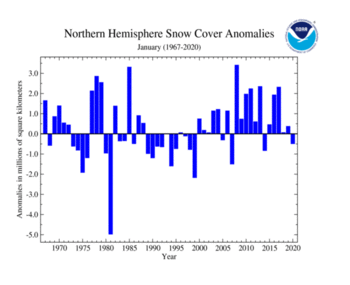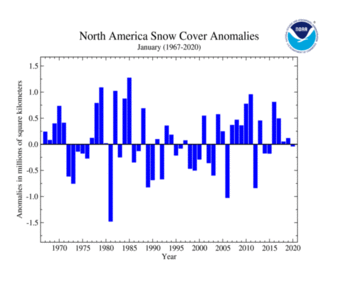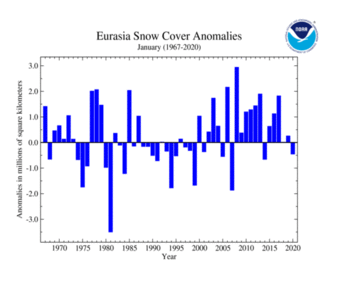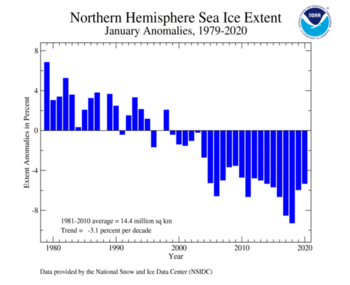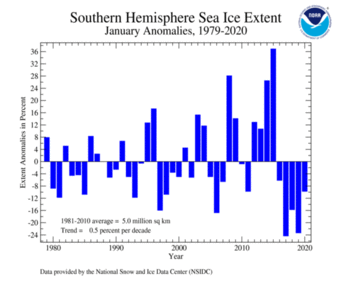NH Snow Cover Extent
| January 2020 | Snow Cover Extent | Anomaly 1991-2020 | Trend per decade | Rank (54 years) | Record | ||||||
|---|---|---|---|---|---|---|---|---|---|---|---|
| million km² | million mi² | million km² | million mi² | million km² | million mi² | Year(s) | million km² | million mi² | |||
| Northern Hemisphere | 46.38 | 17.91 | -0.86 | -0.33 | +0.14 | +0.05 | Largest | 36th | 2008 | 50.28 | 19.41 |
| Smallest | 19th | 1981 | 41.89 | 16.17 | |||||||
| Ties: 1986 | |||||||||||
| North America | 17.51 | 6.76 | -0.08 | -0.03 | +0.01 | +0.00 | Largest | 31st | 1985 | 18.82 | 7.27 |
| Smallest | 24th | 1981 | 16.07 | 6.20 | |||||||
| Eurasia | 28.87 | 11.15 | -0.78 | -0.30 | +0.13 | +0.05 | Largest | 39th | 2008 | 32.27 | 12.46 |
| Smallest | 16th | 1981 | 25.82 | 9.97 | |||||||
Data Source: Global Snow Laboratory, Rutgers University. Period of record: 1967–2020 (54 years)
The Northern Hemisphere snow cover extent during January 2020 was 490,000 square km (190,000 square miles) below the 1981–2010 average and the 18th smallest January snow cover extent in the 54-year period of record. Warmer-than-average conditions were present across much of the Northern Hemisphere. The most notable warmth was present across much of Russia, where temperatures were 5.0°C (9.0°F) above average. However, cooler-than-average temperatures engulfed much of Alaska and western parts of Canada. Overall, this was the smallest January Northern Hemisphere snow cover extent since 2014.
During January 2020, the North American snow cover extent was near average at 17.51 million square km (6.76 million square miles), ranking near the median value in the 54-year period of record. Above-average snow cover extent was observed primarily across the contiguous U.S., specifically across parts of the Northwest, northern Rocky Mountains, and northern Plains. Below-average snow cover extent was present across parts of the contiguous United States' Great Lakes, the Mid-Atlantic regions, and across the southern Plains. Alaska and Canada had their fifth and ninth largest January snow cover extent, respectively, on record. Meanwhile, the contiguous U.S. snow cover extent was near average.
The Eurasian January snow cover extent of 28.87 million square km (11.15 million square miles) was 450,000 square km (170,000 square miles) below average. This was the smallest January snow cover extent since 2014 and the 16th smallest January in the 54-year record. Above-average snow cover extent was observed across much of China and southwestern parts of Asia. Below-average snow cover extent was observed across much of Europe and parts of western Russia.
Sea Ice Extent
The sea ice extent data for the Arctic and Antarctic are provided by the National Snow and Ice Data Center (NSIDC) and are measured from passive microwave instruments onboard NOAA Satellites. The sea ice extent period of record is from 1979–2020 for a total of 42 years.
| January 2020 | Sea Ice Extent | Anomaly 1991-2020 | Trend per decade | Rank (42 years) | Record | ||||
|---|---|---|---|---|---|---|---|---|---|
| million km² | million mi² | Year(s) | million km² | million mi² | |||||
| Northern Hemisphere | 13.64 | 5.27 | -2.43% | -3.15% | Largest | 34th | 1979 | 15.41 | 5.95 |
| Smallest | 8th | 2018 | 13.08 | 5.05 | |||||
| Southern Hemisphere | 4.60 | 1.78 | -8.73% | +0.60% | Largest | 30th | 2015 | 6.85 | 2.64 |
| Smallest | 12th | 2017 | 3.78 | 1.46 | |||||
| Globe | 18.24 | 7.04 | -4.10% | -2.16% | Largest | 35th | 1979 | 20.81 | 8.03 |
| Smallest | 7th | 2017 | 16.97 | 6.55 | |||||
Data Source: National Snow and Ice Data Center (NSIDC). Period of record: 1979–2020 (42 years)
The January average Arctic sea ice extent of 13.65 million square km (5.27 million square miles) was 770,000 square km (297,000 square miles), or 5.3 percent, below the 1981–2010 average, tying with 2014 as the eighth smallest January extent in the 42-year record, according to analysis by the National Snow and Ice Data Center using data from NOAA and NASA. January 2020 also marked the 22nd consecutive January with below-average sea ice extent. Regionally, Baffin Bay had the smallest sea ice extent since January 2011, while the Barents Sea had the largest sea ice extent since January 2015.
Antarctic sea ice extent during January was 4.51 million square km (1.74 million square miles), which is 490,000 square km (190,000 square miles), or 9.8 percent, below the 1981–2010 average. This value tied with January 2011 as the 10th smallest January sea ice extent on record. January 2020 marked the fifth consecutive January where sea ice extent has been below average for the Antarctic.
 NOAA's National Centers for Environmental Information
NOAA's National Centers for Environmental Information
